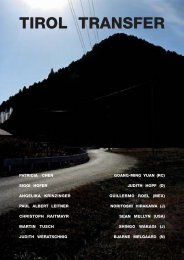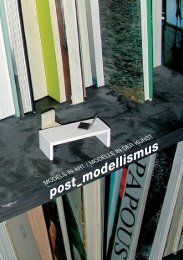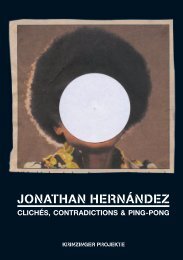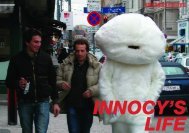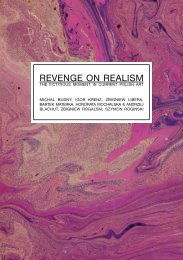Untitled - krinzinger projekte - Galerie Krinzinger
Untitled - krinzinger projekte - Galerie Krinzinger
Untitled - krinzinger projekte - Galerie Krinzinger
You also want an ePaper? Increase the reach of your titles
YUMPU automatically turns print PDFs into web optimized ePapers that Google loves.
TATYANA LIBERMAN20THE BODY AS REFLECTIONO.Shishkin, in: "The Body as Reflection",Segodnya, Nov. 25th 1994 (excerpt)Parts amount to more than the whole. Thenumber of details cannot be ascertained.If we view parts on the whole and thewhole world as a particular instance, wecan make a definite conclusion: detailsare always more impressive than whatthey make up because they are closer tous and more concrete.Lying on the beach on a summer holidaywe are in a most directly tangible contactwith a colossal cosmic body. But wecertainly don’t see it as an astronautwould from the orbit. Our immediatejudgement is that the Earth is a flatsurface overgrown with grass andstretching to infinity. The farther away weare removed from the object, the morechanged it looks. From the far edges ofour galaxy the Earth must look like a pointof light and still farther away - thephantom will totally disappear from view.The works of Tatyana Liberman study theexistence of an object in its transition fromthe particular to the general. The shadowplays the role of a brake in that process,which is needed for close scrutiny. Thesubject thoroughly examined in them isthe sculptured female torso, armless andheadless, as found in excavations ofancient ruins by the Europeans of theclassical revival period. The words"ancient Greek or Roman" actually soundto us as synonyms of "fragmentary". Weare used to looking at broken statuesvisualizing them as whole in our minds.But that is the charm of the past - it canonly be properly seen by the schizophrenicfragmentary consciousness.The shadow has with Liberman stillanother important function - a disorientingone. The mesh through which light falls onthe rough surface exists only in theimagination of the onlooker as a call fromemptiness, a simulation of the nonexistent.Where might the strange scenesdepicted in the photographs take place?Just in the mind of the artist who provokesthe environment to generatephantoms? Or in the world of variations inthe brain of God, or some God-likeSupercatalog where the eternal creationof sculptured human trunks must betaking place? Armless, legless, headlessancient marbles are rotating in semi-darkness,strangely weightless, somewhatlike X-mas tree decorations. [ … ]It would be even more logical to viewLibermans experiments from anotherangle - as experiments conducted onpeople. A live nude body has always symbolizedin art the absence of time,arbitrariness of space, and strangeness ofBeing. "Enough of the black", said Degas."Enough of the white", we might echo.Between black and white are the ancientmarble torsos - just traces of light on thesurface of the photographic film.right page (top and bottom):TATYANA LIBERMAN“Anonymae”, 1999b/w photography, Ed. 1055 x 74 cm



